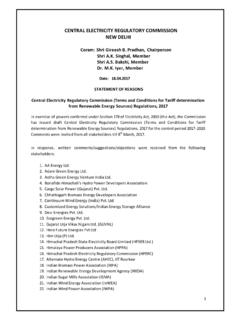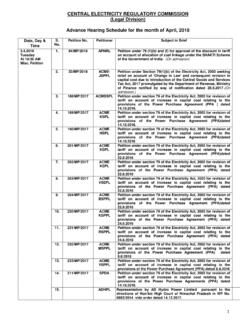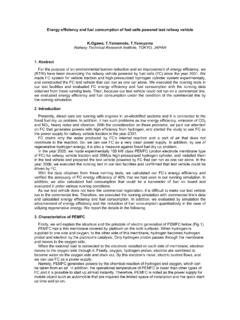Transcription of TERMS AND CONDITIONS OF TARIFF REGULATIONS
1 TERMS AND CONDITIONS OF TARIFF REGULATIONS Approach Paper for Control Period TO Central Electricity Regulatory Commission 3rd & 4th Floor, Chandralok Building, 36, Janpath, New Delhi 110001 website: Blank Page Contents Introduction Basic Approach for TARIFF Setting Prospects for TARIFF Regulation, 2014-19 i) Financial Norms (Hybrid Approach) ii) Operational Norms Financial Norms ( Hybrid Approach) Capital Cost Renovation and Modernisation Depreciation Net Fixed Asset v/s Gross Fixed Asset Debt : Equity Ratio Return on Investment ROE v/s ROCE Return on Equity (RoE) Cost of Debt Interest on Working Capital Operation and Maintenance Norms Alternate TARIFF Design: Based on First year TARIFF with Indexation for Balance Life Operational Norms Approach for Operational Norms Operational Norms for Thermal Generation Station Heat Rate Specific Secondary Fuel Oil Consumption Auxiliary Energy Consumption Normative Annual Plant Availability Transit and Handling Losses Operational Norms for Thermal Power Plant based on Coal Rejects Operating Norms for Hydro Station Operating Norms for Transmission System Incentive Additional Issues Availability of Fuel (Thermal Generation)
2 TARIFF Application Methodology Abbreviations Approach Paper for TERMS and CONDITIONS of TARIFF , 2014-19 Central Electricity Regulatory Commission 3 Introduction The Central Commission has been vested with the functions under the Electricity Act, 2003 (the Act) to regulate the TARIFF of the generating companies owned or controlled by Central Government, generating companies having a composite scheme for generation and sale of electricity in more than one State, to regulate inter-State transmission of electricity and to determine the TARIFF for inter-State transmission in electricity among other functions. Section 61 of the Act requires the Commission to specify the TERMS and CONDITIONS for the determination of TARIFF .
3 Further, section 178(2) (s) of the Act empowers Central Commission to make REGULATIONS on the TERMS and CONDITIONS for the determination of TARIFF under section 61. The Central Commission has issued TERMS and CONDITIONS of TARIFF for period 2001-04 under Electricity Regulatory Commissions Act, 1998 and after enactment of Electricity Act, 2003, the Commission has issued the REGULATIONS on TERMS and CONDITIONS of TARIFF for the control periods 2004-09 and 2009-14. CERC ( TERMS and CONDITIONS of TARIFF ) Regulation, 2004 for to along with statement of reasons was issued vide notification no. L-7/25(5)/2003-CERC on 26th March 2004 and is available on website (weblink: ). The CERC ( TERMS and CONDITIONS of TARIFF ) REGULATIONS , 2009 for period to was issued vide notification (160)/2008-CERC date 19th January, 2009 (weblink: ) In accordance with the REGULATIONS issued from time to time as aforesaid, the Commission has been determining the TARIFF of the generating stations covered within its jurisdiction and inter-State transmission of electricity through transparent and participative process.
4 At the end of the 11th Plan (ending on 31st March,12), the Central Commission has determined the TARIFF for about MW installed capacity of central sector and MW capacity of Private sector/Joint venture companies and associated inter-state transmission system. Section 61(i) of the Act provides that while specifying the TERMS and CONDITIONS of TARIFF , the Commission shall be guided by the National Electricity Policy and TARIFF Policy. The Central Government in exercise of its powers vested under section 3 of the Act has notified the TARIFF Policy on 6th January 2006. Para of the TARIFF Policy provides that all future requirements of power should be procured competitively by distribution licensees except in case of expansion of existing projects or where a State controlled or owned company is an identified developer.
5 The TARIFF Policy mandates that even the TARIFF for all the new generation and transmission projects should be decided on the basis of competitive bidding after a period Approach Paper for TERMS and CONDITIONS of TARIFF , 2014-19 Central Electricity Regulatory Commission 4 of five years ( after 5th January, 2011) with certain exceptions. The TARIFF policy, also therefore recognises that the TARIFF for existing generation and transmission projects shall continue to be determined through regulatory TARIFF mechanism. The Commission, while determining the TARIFF , takes into account objectives of safeguarding consumer interest as well as ensuring recovery of cost of electricity in a reasonable manner. To achieve these objectives, the Commission undertakes various regulatory measures which are consistent with the principles set out under section 61 of Electricity Act, 2003 and TARIFF Policy, 2006.
6 The TERMS and CONDITIONS of TARIFF specified by the Central Commission for determination of TARIFF for generating companies and transmission licensees also act as guiding principles for the State Electricity Regulatory Commissions. For TARIFF period 2014-19, the existing TARIFF norms may have to be reviewed by keeping in view the developments in the sector during the ongoing TARIFF period, current and perceived challenges in the Power sector and duly recognizing the need for sustainable market development. Though it is important to maintain regulatory certainty in TARIFF approach, the TARIFF should reflect the changing market CONDITIONS . The purpose of this approach paper is aimed at soliciting views of stakeholders on the different aspects of TARIFF setting during control period 2014-19. Basic Approach of TARIFF Setting As per the approach paper floated by Planning Commission for the 12th Plan, the GDP growth rate of per cent per year will require the energy supply to grow at about and per cent per year.
7 Therefore, it is important to harness all the available resources to increase power generation and corresponding transmission systems to carry the power to the load/demand centres. The approach of TARIFF setting plays important role for attracting investment in power generation and transmission. In line with the objectives of safeguarding consumer interest and to ensure recovery of cost of electricity in a reasonable manner, performance based cost of service regulation was adopted in previous TARIFF periods. The hybrid approach, consisting of norms on actual cost of service and pre-specified normative cost basis was being followed to induce efficiency in financial and operational performance. Under the Availability Based TARIFF (ABT), two part TARIFF structure (fixed +variable cost) is being followed for generation TARIFF with incentive and Approach Paper for TERMS and CONDITIONS of TARIFF , 2014-19 Central Electricity Regulatory Commission 5 disincentive mechanism.
8 Recovery of fixed charges is based on the availability of plant while the recovery of variable charges is linked to operational parameters like normative Station Heat Rate (SHR), auxiliary consumption etc. The fixed charges have five components namely Return on Equity (ROE), Interest on Loan, Deprecia0tion, Operation & Maintenance cost, and Interest on Working Capital. There are incentive/ disincentives built in for over/under achievement of target availability and normative parameters. The TARIFF structure of transmission system is governed through single component of annual fixed charges with incentive linked to availability. The congestion charges and sharing of transmission charges are notified through separate REGULATIONS . Prospects for TARIFF Regulation 2014-19 In view of the anticipated growth in demand and the existing challenges in the power sector, a balanced approach is required to be adopted for TARIFF determination in the larger interest of the sector.
9 Further, a focus is needed to improve the operational efficiency so that benefit on account of efficiency gains should be shared with the beneficiaries and the consumers at large. It is equally important to harness all resources to increase proportionate mix of power generation. i) Financial Norms ( Hybrid Approach): The existing TARIFF setting follows a hybrid approach where performance based cost of service approach by considering actual cost and normative parameters specified in the REGULATIONS . Components like return on equity, operation and maintenance expenses and interest on working capital have been specified on normative basis whereas cost of debt have been on actual basis. The Capital cost of project including interest during construction and financing charges, any gain or loss on account of foreign exchange rate variation, capitalized initial spares and additional capital expenditure etc.
10 Have been admitted after prudence check. The normative parameters are expected to induce operational and financial efficiency. While continuing with the hybrid approach, ensuing TARIFF REGULATIONS for the control period 2014-19 may provide more weightage for normative parameters to induce efficiency during operation as well as in development phase. ii) Operational Norms : The operational norms and the methodology to determine such norms should reflect the optimum level of efficiency during next TARIFF period. Approach Paper for TERMS and CONDITIONS of TARIFF , 2014-19 Central Electricity Regulatory Commission 6 Financial Norms (Hybrid approach) Capital Cost The determination of Capital cost is a critical step in TARIFF .













